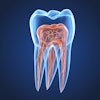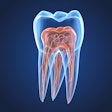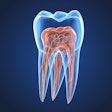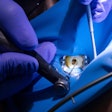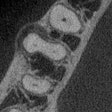
Recommending root canal treatment to potentially prevent a heart attack may seem like a stretch now, but one day it could be reality. A recent research article has linked endodontic lesions to cardiovascular disease.
 John M. Liljestrand, DDS, is a doctoral candidate at the University of Helsinki.
John M. Liljestrand, DDS, is a doctoral candidate at the University of Helsinki.Researchers from Finland, the U.S., and Chile found that the more apical rarefactions a person has, the more likely they are to have coronary artery disease. Their findings were published online ahead of print in the Journal of Dental Research (July 27, 2016).
"Our study further consolidates the current concept that oral inflammations have an exacerbating effect on CVDs [cardiovascular diseases]," stated lead author John M. Liljestrand, DDS, a doctoral candidate at the University of Helsinki, in an email to DrBicuspid.com.
What do lesions have to do with heart disease?
Previous research has established that inflammation, particularly periodontitis, is associated with an increased risk of cardiovascular diseases. Because endodontic lesions and periodontal disease have similar properties, Dr. Liljestrand and colleagues wanted to see if apical periodontitis and heart disease were associated as well.
"Apical periodontitis is similar to marginal periodontitis regarding its microbial profile and ability to increase systemic inflammatory markers," he said. "Therefore, it is justified to suggest that apical periodontitis might also increase the risk for CVDs."
To test their hypothesis, the researchers recruited a random sample of 508 adult patients in Finland who underwent coronary angiography, a test that measures plaque in the coronary arteries, from 2006 to 2008. They then divided the patients into groups by the severity of their disease:
“Oral inflammations have an exacerbating effect on CVDs [cardiovascular diseases].”
- 123 people with no significant coronary artery disease
- 184 people with stable coronary artery disease
- 169 people with acute coronary syndrome (ACS), putting them at risk for a heart attack
- 32 with ACS-like symptoms but no coronary artery disease
A dental expert who was blinded to the patients' coronary diagnoses also took radiographs, blood samples, and bacteria samples from the 476 patients who still had teeth. The researchers once again divided the patients into groups, this time based on the prevalence of endodontic lesions:
- 210 patients, including 32 edentulous patients, with no endodontic lesions
- 222 patients with a widened periapical space and/or one apical rarefaction
- 76 patients with two or more apical rarefactions
Once the data were collected, Dr. Liljestrand and colleagues compared the lesion results with coronary artery disease information using three separate models, each accounting for various factors, such as age, body mass index, and bone loss.
All three models showed a statistically significant correlation between having at least one widened periapical space and having stable coronary artery disease. The models also found that having at least one apical rarefaction in teeth without a root canal filling was significantly associated with having acute coronary syndrome.
| Odds ratio of having stable coronary artery disease if a person has at least 1 widened periapical space | ||
| Model | Odds ratio (OR) | p-value |
| Model 1 (adjusted for age and sex) | 1.63 | 0.047 |
| Model 2 (adjusted for smoking, diabetes, and body mass index) | 1.78 | 0.027 |
| Model 3 (adjusted for bone loss and number of teeth) | 1.94 | 0.016 |
| Odds ratio of having acute coronary syndrome if a person has at least 1 apical rarefaction in teeth without a root canal filling | ||
| Model | Odds ratio (OR) | p-value |
| Model 1 (adjusted for age and sex) | No data provided | N/A |
| Model 2 (adjusted for smoking, diabetes, and body mass index) | 2.77 | 0.018 |
| Model 3 (adjusted for bone loss and number of teeth) | 2.72 | 0.022 |
"Interestingly, the OR values were highest for those who had apical periodontitis in teeth without past root canal treatment, suggesting that root canal treatment might have an attenuating effect on the studied association with CVDs," Dr. Liljestrand said. "However, this needs to be further studied before making such conclusions."
In addition, the more lesions a person had, the more likely they were to have Porphyromonas endodontalis, which has previously been linked to coronary artery disease, as it is able to invade smooth muscle cells and vascular walls.

Aim to reduce inflammation
A key limitation of this study was that it did not include a healthy population for reference. However, even among comparing those who underwent coronary angiography, the results were significant and suggested that, like periodontitis, inflammation around roots also may be linked to heart disease.
The researchers hope future studies further explore the relationship between endodontic lesions and heart disease, including whether performing root canal treatments can minimize or mitigate coronary artery disease risk. Meanwhile Dr. Liljestrand will continue to research the relationship between periodontitis and heart disease, specifically looking at the role of pathogens and inflammatory markers.
Regardless of future research plans, to Dr. Liljestrand, the bottom line of this study is clear: Maintaining proper oral hygiene is important for keeping your mouth -- and your heart -- healthy.
"The most common oral inflammatory diseases are often asymptomatic, and they are largely preventable by appropriate oral hygiene routines. Therefore, it is highly important for anyone to regularly visit a dental office for examination," he said. "Practitioners should pay special attention to teeth with large fillings or past root canal treatment, while they have a higher risk for apical periodontitis."

